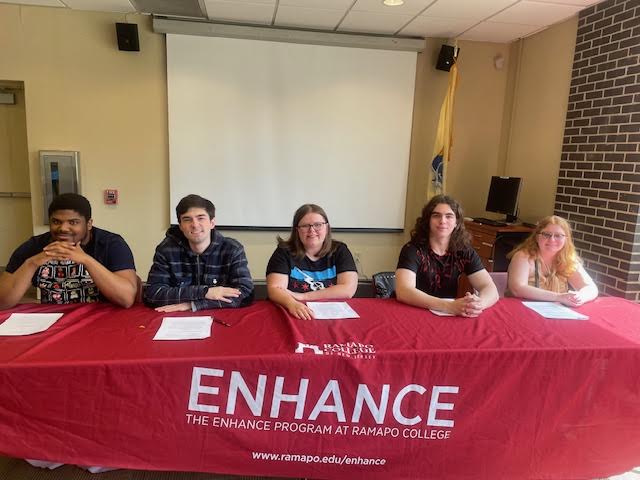April brings not only the beginning of spring, but the celebration of Autism Acceptance Month (AAM). This celebration offers the opportunity to highlight the autistic experience as well as educate others about how varied the autism spectrum is.
Ramapo’s ENHANCE program, a therapeutic program dedicated to helping students on the autism spectrum to flourish in college and afterwards, held a panel on Monday made up of students on the spectrum who discussed their experiences.
Hosting the panel was executive director of ENHANCE Suzanne Calgi, who moderated the discussion between music major Kyle DeSuza, vice president of the Geek and Nerd Culture Club Nigel Richardson, junior MG Laffin, freshman prospective music major Isaac Nevins and freshman digital filmmaking major Julianna Mayer.
The purpose of the panel was to expand on Dr. Stephen Shore’s quote: “If you’ve met one person with autism, you’ve met one person with autism.” This quote signifies how diverse the spectrum is, and that one autistic person does not necessarily share the same exact traits of another.
The panel’s discussion was wide-ranging, covering a variety of topics and clarifying some ways that are appropriate for talking about autism. For example, the panelists agreed that it’s much more comfortable to be called “autistic.”
“I prefer to just say it how it is: I’m autistic,” Richardson said. “I really don’t like the idea of calling it a disorder because that just feels dehumanizing and degrading.”
Another topic covered was the common stereotype that autistic people lack empathy. Not only does an idea such as this one deny an autistic person’s humanity, but the panelists assured it was simply wrong overall.
Nevins argued against this notion, saying, “I would say for myself that I have high empathy. I have a lot of empathy, for that matter. We’re all different and I understand that it’s different for everyone… but at the same time there’s also neurotypical people out there that have low [empathy]…”
Near the end of the conversation, Mayer introduced a way to look at the spectrum. She found that many people think of the spectrum incorrectly as ranking someone as “more autistic” or “less autistic.” Rather, she asked the audience to look at it like a pie chart.
“On this pie chart, you can have eye contact, you can have stimming, you can have special interests, you can have empathy, social cues, communication, things like that. Everyone’s pie chart is going to look different, but everyone’s pie chart is all going to equal 100% autistic,” she said.
The conversation turned to a Q&A section where people could ask other questions about misconceptions or the panelists’ experiences with being on the spectrum. One point that was mentioned was the use of the puzzle piece as a symbol for autism.
“The idea of a puzzle piece being representative of autistic people… implies that we as people have something that we’re missing, that we need to be fixed, like an enigma that needs to be solved,” Richardson said.
Instead of the puzzle piece, the panelists brought up the symbol of the rainbow infinity sign, as it is more inclusive and further supports the idea of variety on the spectrum.
Nevins added to this the misrepresentation of the organization Autism Speaks, as he elaborated the lack of autistic voices behind the organization’s mission.
Not only was the panel an opportunity for people to learn about the misconceptions of autism, but they were able to learn more about their peers. Some questions throughout the panel focused on common traits seen in autistic individuals such as sensory overload, an occurrence where the senses are receiving information too fast for the brain to process, resulting in the body responding in panic.
While many of the panelists mentioned their experiences with sensory overload, commonly caused by the layering of multiple sounds, DeSuza found that he did not face the same struggles.
“There is an incredible diversity within the autism spectrum and no one person or characteristic or profile defines what the autism spectrum is,” Calgi said.
pbortner@ramapo.edu
Featured photo courtesy of Suzanne Calgi






